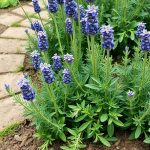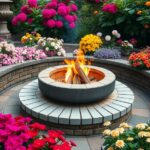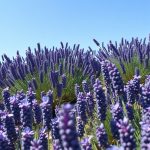Fire-resistant landscaping not only enhances your home’s curb appeal but also adds an extra layer of protection against wildfires. Whether you’re in a high-risk area or just looking for ways to create a safer outdoor space, we’ve compiled 23 creative ideas that combine aesthetics and functionality. From choosing the right plants to designing your hardscape, jump into these tips and make your landscape both beautiful and resilient!
Water Features for Moisture
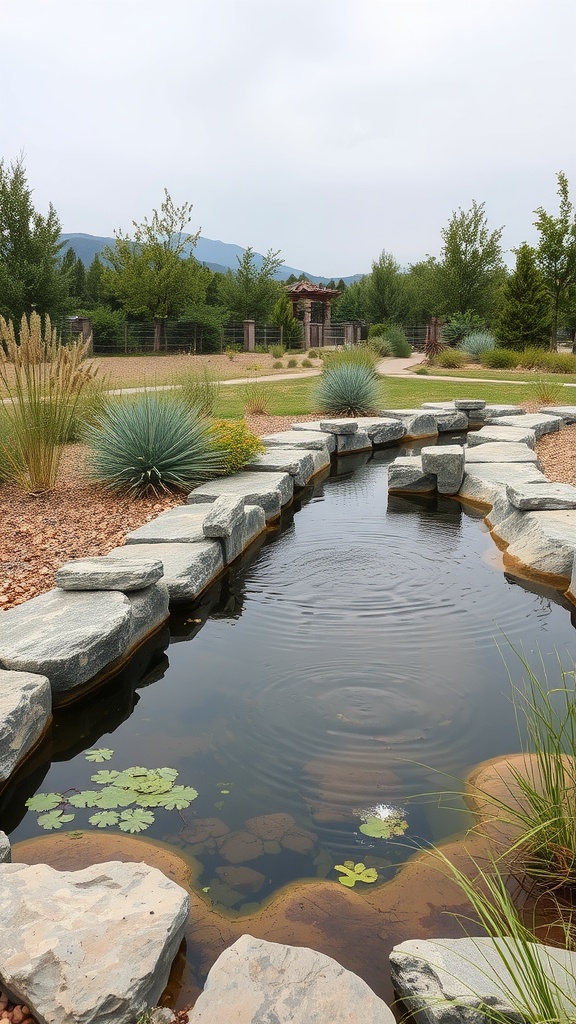
Water features are a fantastic addition to any fire-resistant landscape. They not only provide a beautiful focal point but also help maintain moisture in the surrounding area. The image shows a serene pond bordered by smooth stones, surrounded by greenery that enhances its natural appeal.
The calm water reflects the surrounding plants, creating a soothing environment. Adding elements like lilypads can attract wildlife, making your yard more vibrant. This balance of water and greenery acts as a natural barrier against fire, as moist plants are less likely to ignite.
Incorporating a water feature can also create a refreshing microclimate in your garden. It can be as simple as a small pond or a trickling stream. Either way, it adds charm and helps keep your landscape moist, which is essential in fire-prone areas. Overall, a water feature is a great choice for blending beauty and function in your landscaping efforts.
Drought-Tolerant Succulents
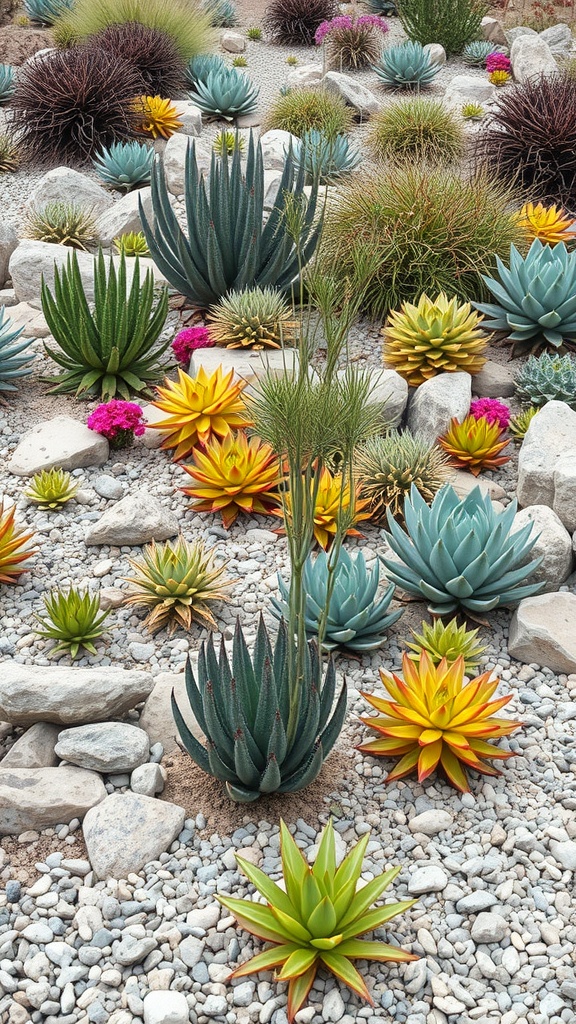
In the image, you see a vibrant display of drought-tolerant succulents that thrive in dry conditions. These plants come in various shapes and colors, creating a visually stunning landscape. The contrast between the greens, yellows, and pinks adds a lively charm to any garden.
Succulents are perfect for fire-resistant landscaping. They store water in their leaves, making them resilient even in the hottest summers. This characteristic not only helps them survive droughts but also minimizes the risk of fire spreading in your garden.
Incorporating succulents into your landscape design is a smart choice. They require little maintenance and can be planted among rocks, gravel, and other drought-resistant materials. This setup not only looks great but also conserves water and reduces fire hazards.
Consider planting a mix of tall and short succulents to create depth in your garden. Their unique forms and colors can bring an artistic touch to your outdoor space. Plus, with the right arrangement, you can have a stunning display all year round.
Stone Pathways
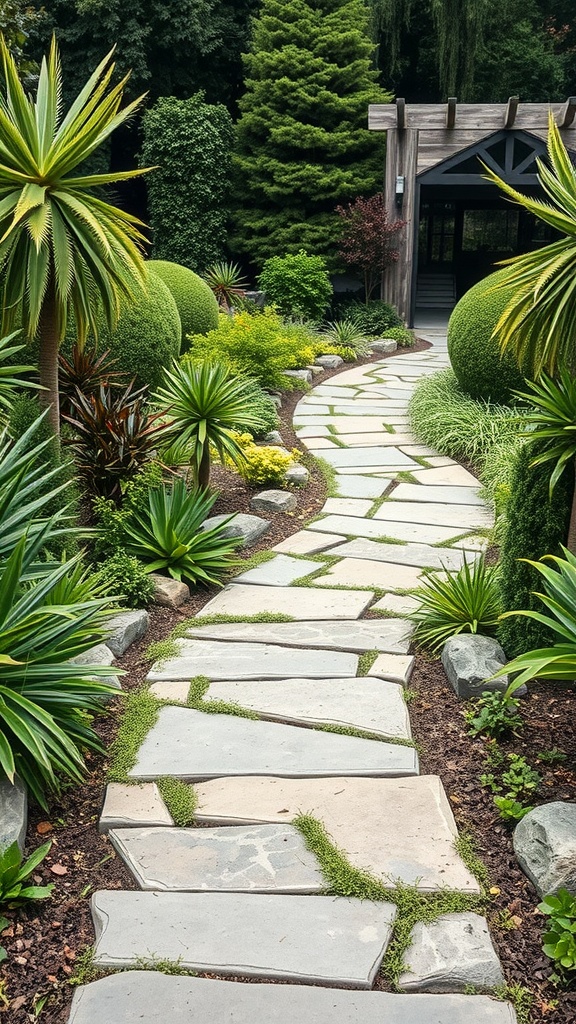
Stone pathways are a great choice for fire-resistant landscaping. They add a natural touch that complements any garden. The image shows a beautiful stone path winding through lush greenery. The stones are arranged in a way that creates a charming and inviting atmosphere.
Using stone for your pathways is practical too. These materials are non-combustible, making them less likely to catch fire compared to wood or other flammable materials. Plus, they can withstand weather changes without damage.
Consider adding low-growing plants or moss in the gaps between the stones. This can soften the look and provide extra greenery. The contrast between the hard stone and soft plants creates a balanced space that’s easy on the eyes.
Designing a stone pathway is straightforward. You can place the stones in a straight line for a modern look or create a meandering path for a more relaxed feel. Either way, you have a stunning feature that enhances both beauty and safety in your garden.
Windbreaks with Trees
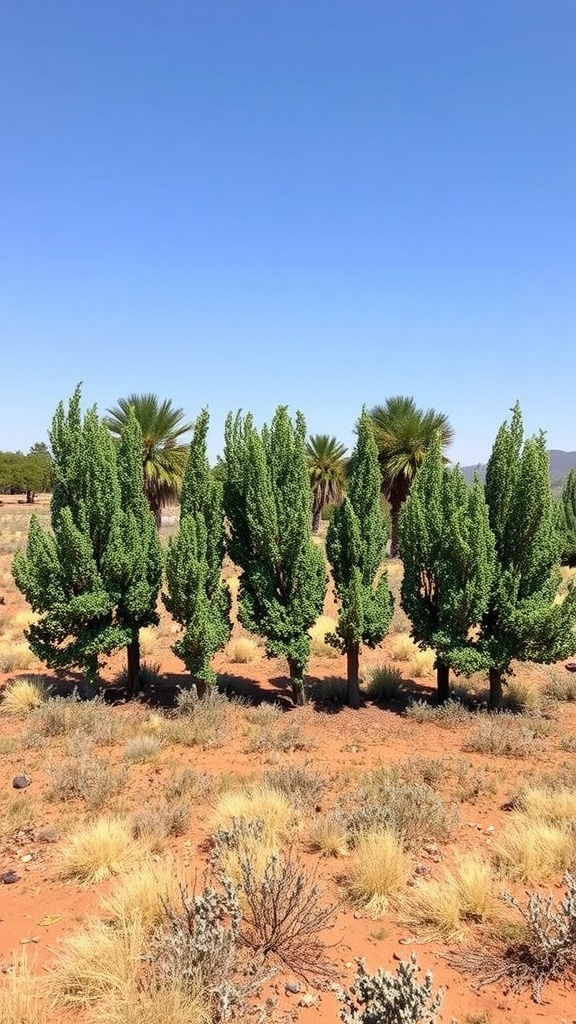
Creating windbreaks with trees is a smart way to protect your home and garden from strong winds. The image shows a row of tall, bushy trees that serve this purpose well. These windbreaks can slow down wind speed, reducing the risk of fire spreading to your property, which is crucial in fire-prone areas.
Choosing the right trees is key. Look for species that are known to be fire-resistant. The trees in the image appear healthy and well-maintained, providing a strong barrier. Not only do they protect against wind, but they also offer shade and enhance your landscape’s beauty.
Spacing is also important. Planting trees too close together can lead to competition for nutrients and water. The arrangement seen here allows each tree to thrive while creating an effective windbreak. Over time, these trees will grow, making your property even safer and more enjoyable.
Native Plant Gardens
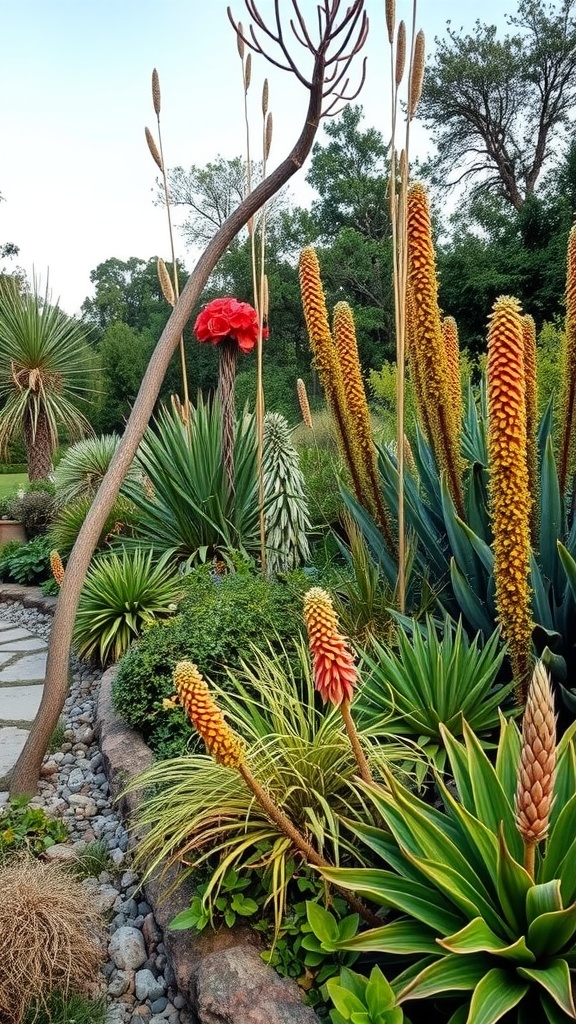
Native plant gardens are a fantastic way to create a fire-resistant landscape. The image shows a diverse array of native plants, showcasing their unique shapes and colors. These plants are well-adapted to local conditions, making them lower maintenance and more resilient.
In the picture, you can see tall, spiky plants that bring height and drama to the garden. The vibrant red bloom stands out, drawing the eye. This mix of textures and colors not only looks beautiful but also attracts local wildlife, such as birds and pollinators.
Choosing native plants can reduce the need for fertilizers and pesticides, which is better for the environment. Plus, they usually require less water once established. This makes them a smart choice for anyone looking to save on gardening efforts while still enjoying a stunning outdoor space.
Incorporating native plants into your landscaping can create natural beauty and enhance your home’s fire resistance. They can help create barriers that slow down fire spread and protect your property, giving you peace of mind while loving your landscape.
Permeable Pavement
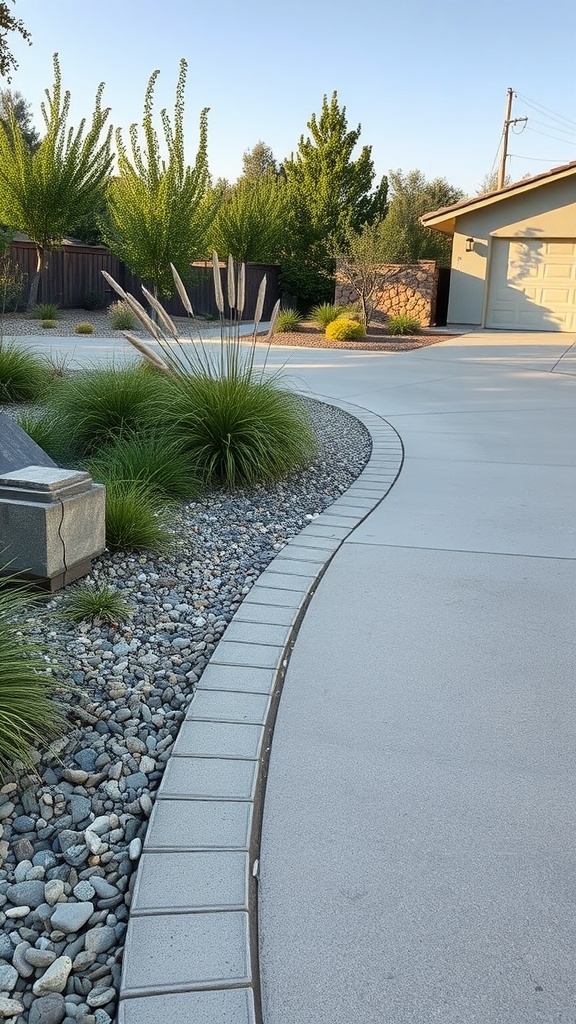
Permeable pavement is a fantastic choice for fire-resistant landscaping. The image shows a beautifully designed area with smooth, gray concrete and decorative stones along the edges. This setup not only looks great but also helps manage water drainage effectively.
The design promotes natural water absorption, reducing runoff and keeping the landscape healthier. Using permeable materials minimizes the risk of fire as they tend to remain cooler and can be more resistant to flames. Plus, they can complement various plantings, like the grasses and shrubs shown here, creating a seamless blend of beauty and functionality.
When choosing permeable pavement, consider options like interlocking pavers or porous concrete. These materials allow rainwater to seep through, which can be a game changer in preventing erosion and maintaining soil moisture. This approach is practical and eco-friendly!
Fire-Resistant Mulches
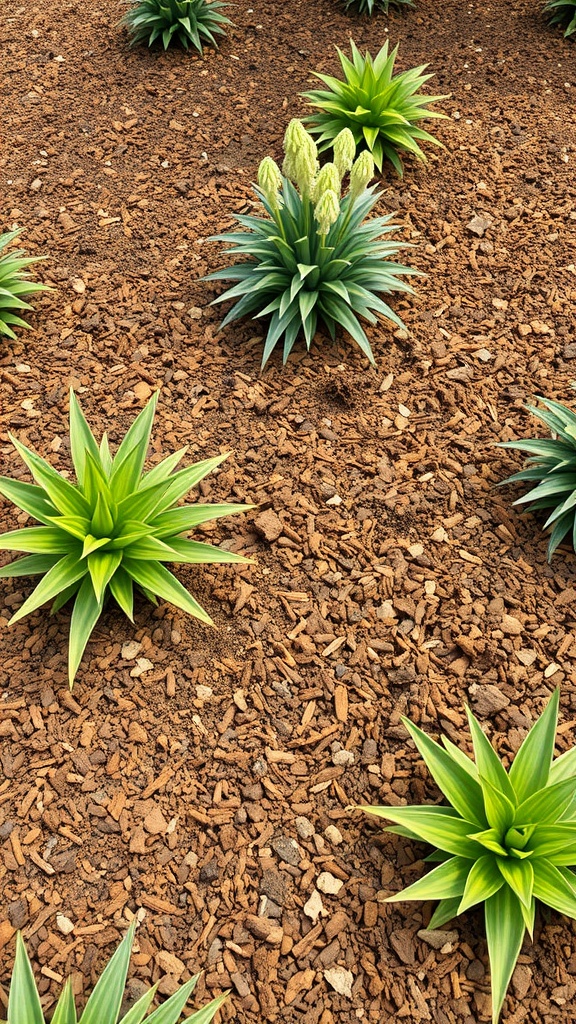
Fire-resistant mulches are a smart choice for landscaping, especially in areas prone to wildfires. The image shows a well-maintained landscape featuring vibrant green plants surrounded by a layer of brown mulch. This combination not only looks appealing but also serves a practical purpose.
Using mulch made from materials like cedar, rubber, or gravel can help reduce fire risk. These materials are less likely to ignite compared to traditional mulches like bark or pine needles. When you create a landscaped area with fire-resistant characteristics, you enhance safety while still enjoying a beautiful yard.
The plants in the image are strategically placed, allowing for good airflow, which can also reduce fire hazards. Pairing these plants with the right mulch creates a fire-safe environment, so you can relax knowing your landscaping is both lovely and practical.
Fire-Resistant Hedges
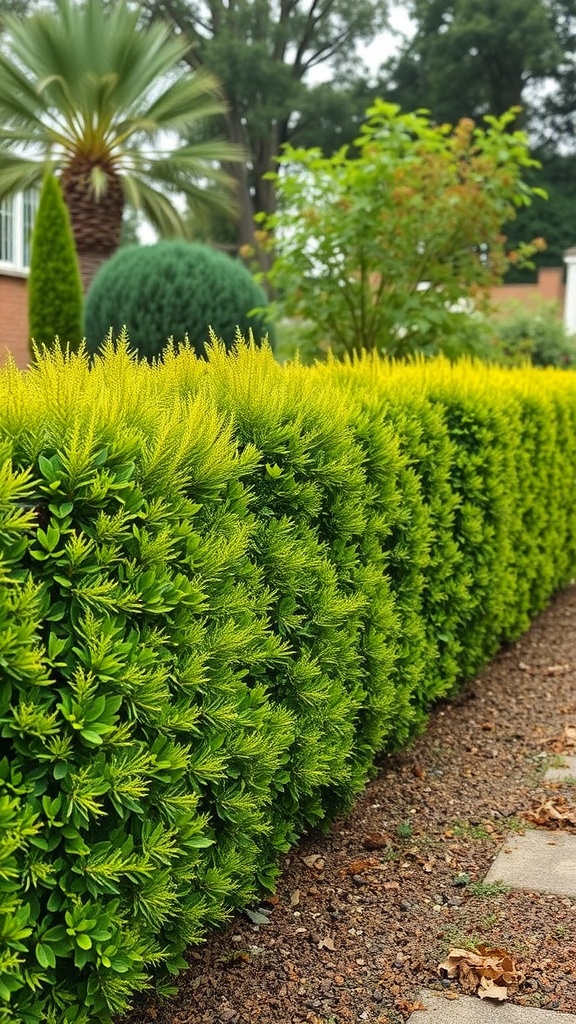
When it comes to landscaping, fire-resistant hedges are a solid choice for both safety and style. These hedges can create a protective barrier while adding beauty to your garden. The image showcases a vibrant row of hedges, which are not only lush but also resilient against fire hazards.
Choosing the right hedge is key. Look for options like Boxwood or Holly, known for their low flammability. They can withstand heat better than many other plants. Plus, their thick foliage helps in slowing down flames, making them ideal for fire-prone areas.
Incorporating these hedges offers a dual benefit: they enhance your yard’s visual appeal while providing peace of mind. Whether you want to define boundaries or add privacy, fire-resistant hedges are a smart pick. Make sure to maintain them well for the best results!
Gravel Beds for Drainage
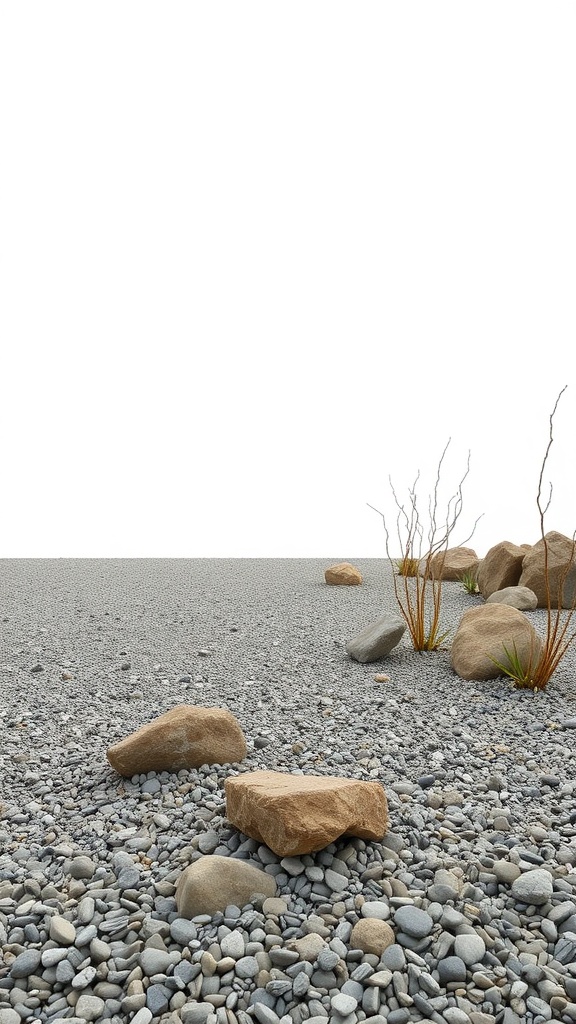
Gravel beds are a smart choice for landscaping, especially if fire resistance is a priority. The image shows a spacious area covered with a mix of large and small pebbles, creating a modern and clean aesthetic.
Using gravel for drainage helps manage water flow, preventing pooling and reducing the risk of fire hazards. When the ground is well-drained, plants are less likely to retain moisture that could fuel a potential fire.
The stones also provide a natural barrier against fire. They don’t burn and can help stop flames from spreading, making them a great option for fire-resistant landscaping.
Plus, gravel beds are low maintenance. They don’t require mowing or regular watering, allowing you to focus on other aspects of your garden. You can easily incorporate drought-resistant plants among the gravel for a beautiful, fire-safe environment.
Overall, if you want a stylish and practical way to protect your home, consider using gravel beds for drainage. They not only enhance your yard but also keep it safe from fire.
Perennial Borders
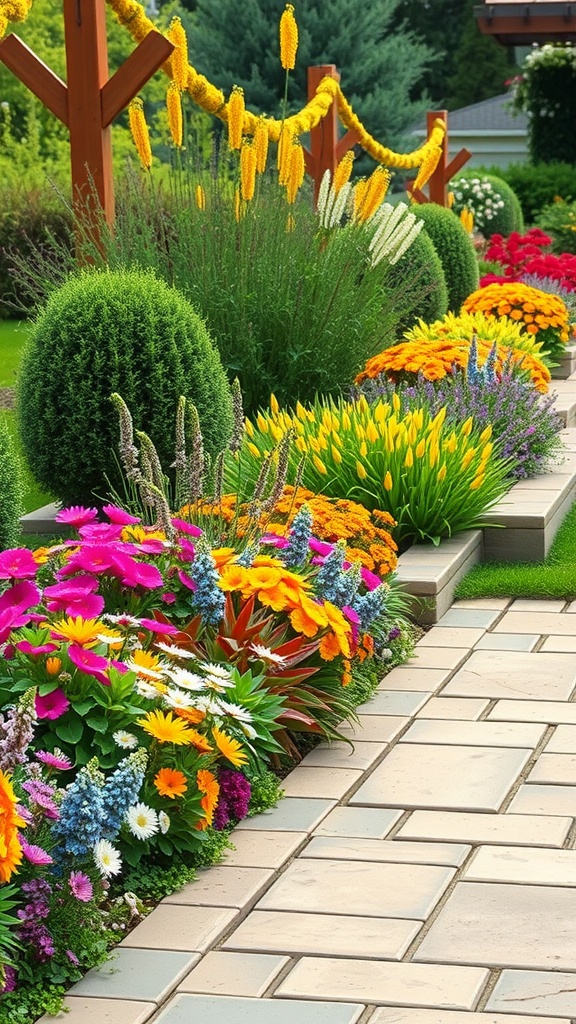
Creating perennial borders is a smart way to add beauty to your outdoor space while keeping fire resistance in mind. The vibrant flowers and well-organized layout can make your garden stand out. Think about colorful blooms like daisies, petunias, and tulips combined with structural plants like boxwoods or lavender.
In the image, you can see a lively array of flowers arranged along a pathway. The bright colors and neat lines draw the eye and invite you to take a stroll. This kind of landscaping not only looks great but can also help slow down flames and provide a safe zone around your home.
Choosing fire-resistant plants is key. Many perennials are not just beautiful; they can withstand heat and dry conditions. Grouping these plants together creates a border that serves both form and function. Plus, they require less maintenance once established, freeing up your time to enjoy your garden.
Fire-Resistant Vegetable Gardens
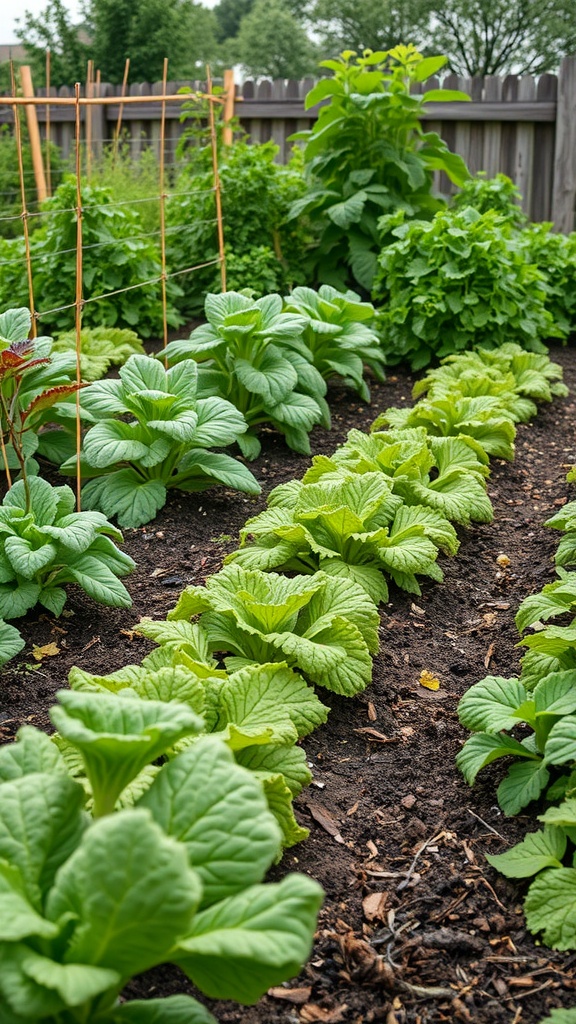
Creating a fire-resistant vegetable garden can be both practical and rewarding. The image displays lush green plants, thriving in well-maintained rows. These vibrant vegetables not only add beauty to your yard but also contribute to your food supply.
Incorporating fire-resistant plants is key. Choose varieties that are less likely to ignite. The leafy greens shown in the image are excellent choices. They can thrive in various climates and help reduce the overall risk of fire spreading.
Designing your garden with space between plants can improve airflow and reduce the chance of flames jumping from one plant to another. Consider adding gravel paths or stone borders to create a safe zone around your veggies. Not only do they look great, but they also offer a practical solution for fire prevention.
Watering your garden regularly keeps the plants healthy and less susceptible to fire. A well-watered garden will not only produce amazing vegetables but also serve as a barrier against flames. Keep an eye on local fire regulations and guidelines to enhance your garden’s safety.
Clay and Adobe Structures
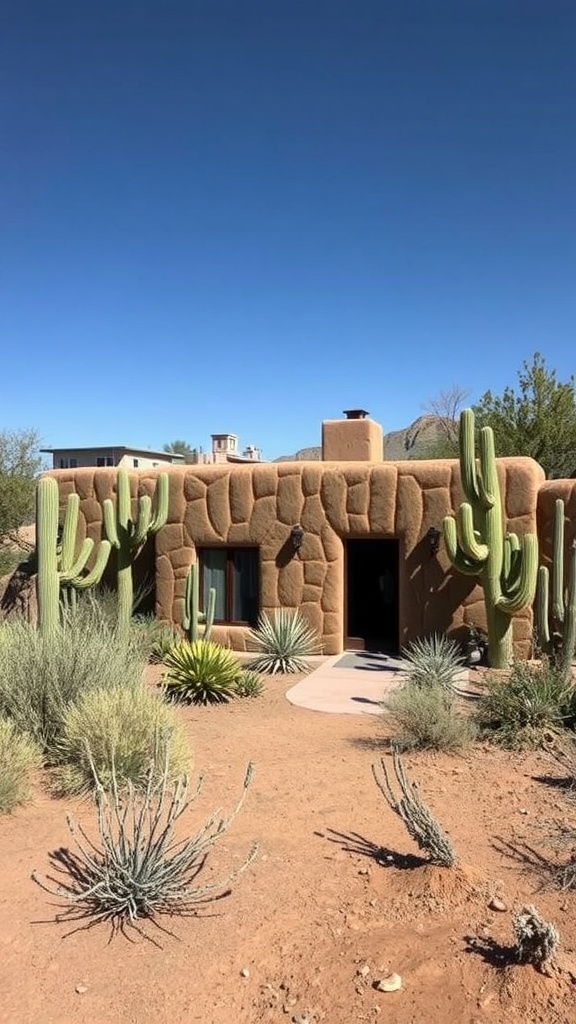
Clay and adobe structures are a fantastic choice for fire-resistant landscaping. These materials have been used for centuries and are known for their durability and thermal mass properties. The image captures a stunning adobe-style home, blending seamlessly into its desert surroundings.
The warm tones of the clay walls harmonize with the natural landscape. This style not only looks great but also offers practical benefits. Adobe is highly effective in fire resistance, making it a smart choice for areas prone to wildfires.
Surrounding the structure, you can see resilient desert plants like cacti and succulents. These plants require minimal water and provide striking visuals, enhancing the overall aesthetic. This type of landscaping promotes sustainability while ensuring safety.
When considering clay and adobe structures, think about how they can complement your outdoor space. Their natural look can create a cozy, inviting atmosphere while being practical for fire safety.
Raised Garden Beds
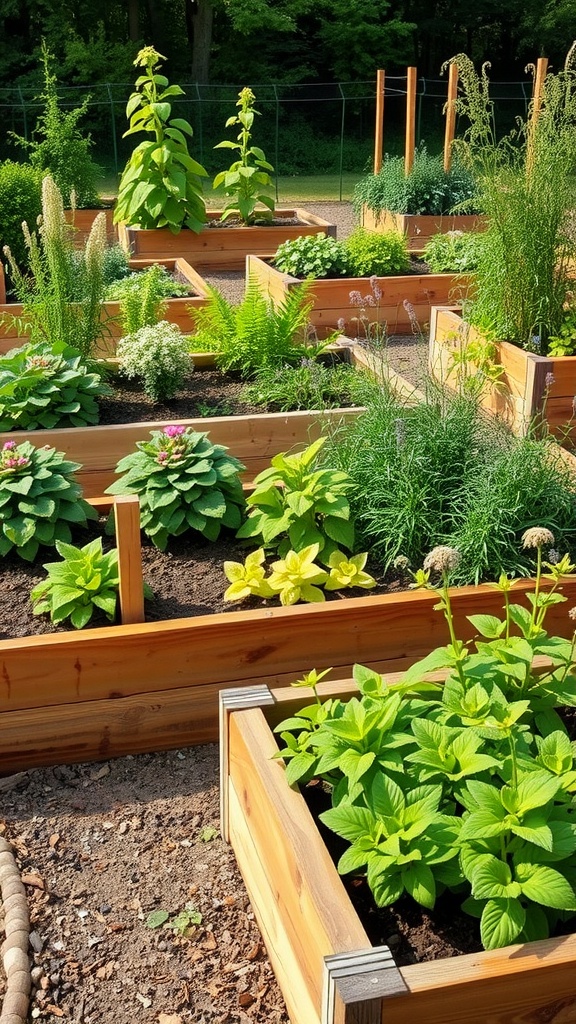
Raised garden beds are a fantastic choice for fire-resistant landscaping. They not only look great but also provide practical benefits. The elevated design keeps plants safe from ground heat and makes it easier to manage your garden.
This image shows a variety of plants thriving in well-structured raised beds. The clean lines of the wooden frames create a neat appearance while allowing for efficient drainage and soil management. You can see a mix of herbs, flowers, and foliage, all contributing to a vibrant garden that can withstand dry conditions.
The layout of the beds makes it simple to access each plant, which is great for maintenance. Plus, these structures can be built with fire-resistant materials, further enhancing safety in fire-prone areas. You can customize the height and width of the beds to fit your space and needs.
Terraced Landscaping
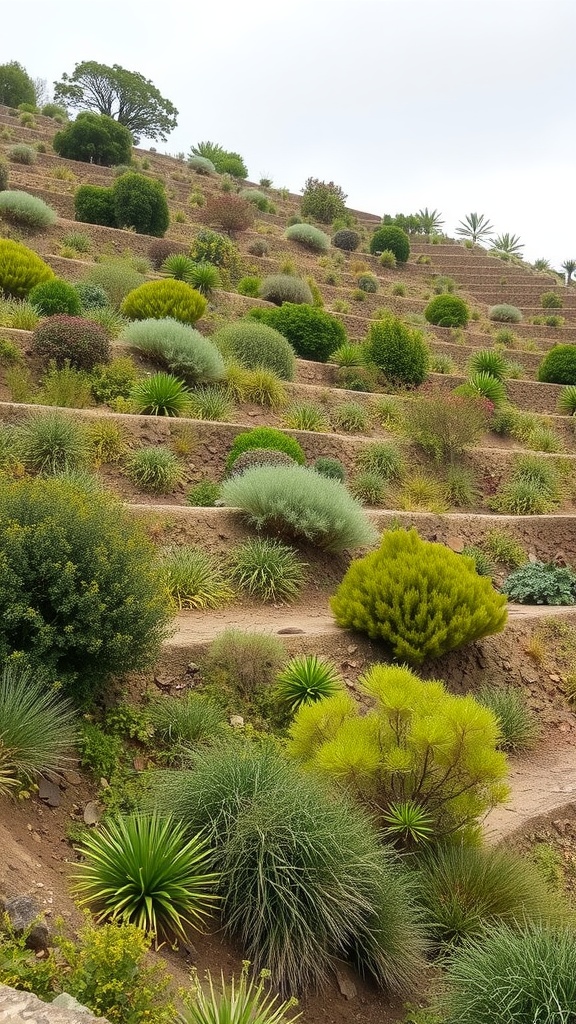
Terraced landscaping is a smart way to create beautiful gardens on sloped land. It helps prevent erosion and makes it easier to manage plants. The image shows a lovely example of this technique, where different levels are built into the hillside, allowing for a variety of plants to thrive.
In the picture, you can see several tiers filled with lush greenery. Each level features different types of plants and textures, adding depth and interest to the overall look. The arrangement not only looks amazing, but it also helps with water drainage and soil retention, which is great for fire-resistant landscaping.
Choosing the right plants is key. Drought-resistant species are a fantastic choice for these terraces. They help reduce the risk of fire while providing color and beauty. You can mix tall shrubs with shorter ground covers to create a layered effect. This can lead to a vibrant and attractive landscape that’s functional too.
Non-Combustible Fencing
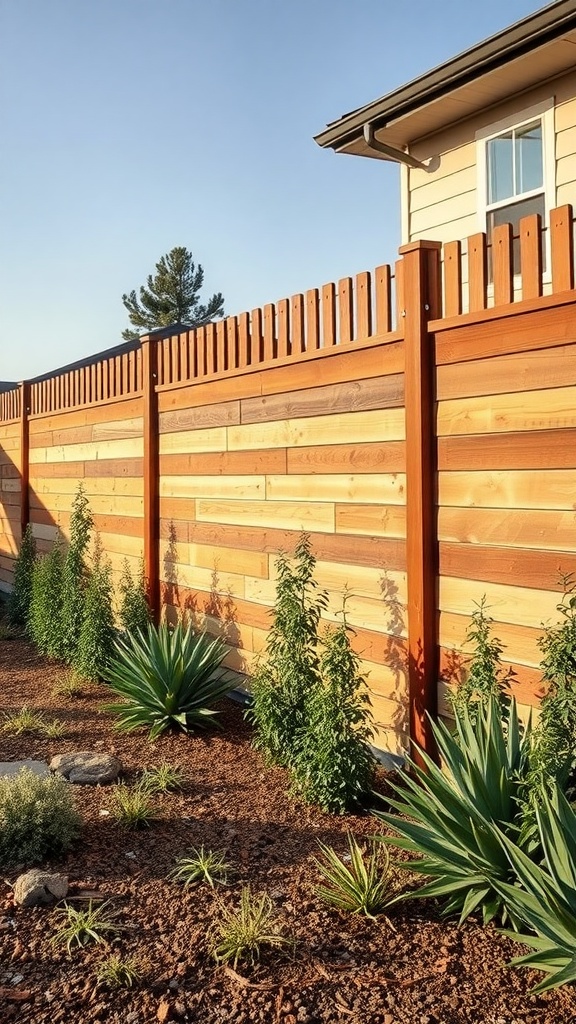
Choosing non-combustible fencing is a smart move for fire-resistant landscaping. The image shows a beautifully crafted wooden fence that adds a warm touch to the outdoor space. It’s designed not just for aesthetics but also for safety.
This kind of fencing can be made from materials like metal or specially treated wood that resists flames. The visuals highlight how well the fence blends with the surrounding plants, creating a functional barrier without sacrificing style.
Using non-combustible materials helps protect your property during wildfire season. It’s reassuring to know that your home is safe while still enjoying an inviting outdoor area. Plus, incorporating fire-resistant plants along the base, as seen here, complements the fencing and enhances the overall look.


